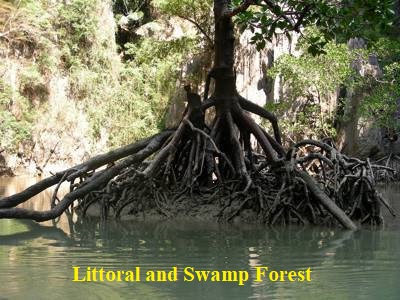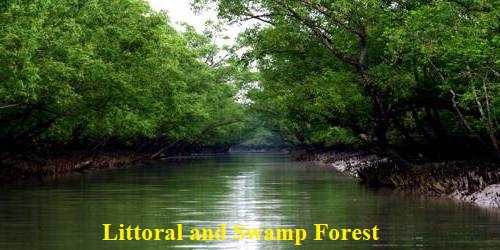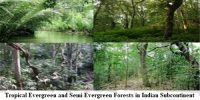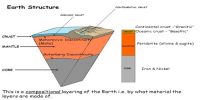Littoral forests and Swamp forests are also called the wetland forests. It consists mostly of whistling pines, mangrove dates, palms, etc. They have roots that consist of spongy tissue so that the plant can respire in the water.
Littoral and Swamp Forests in Indian Subcontinent
India has a rich variety of wetland habitats. It consists mainly of whistling pines, mangrove dates, palms, and bulletwood. About 70 percent of this comprises areas under paddy cultivation. The total area of wetland is 3.9 million hectares. They have roots that consist of soft tissue so that the plant can breathe in the water.

Littoral and swamp forests are found along the Andaman and Nicobar Islands and the delta area of the Ganga and the Brahmaputra. The country’s wetlands have been grouped into eight categories, viz.,
(i) Occur in and around the deltas, estuaries, and creeks prone to tidal influences (delta or tidal forests). The reservoirs of the Deccan Plateau in the south together with the lagoons and other wetlands of the south-west coast;
(ii) The vast saline expanses of Rajasthan, Gujarat and the Gulf of Kaehehh;
(iii) Freshwater lakes and reservoirs from Gujarat eastwards through Rajasthan (Keoladeo National Park) and Madhya Pradesh; Swamp forests are confined to the deltas of the Ganga, the Mahanadi, the Godavari, the Krishna, and the Cauvery.
(iv) The delta wetlands and lagoons of India’s cast coast (Chilika Lake);
(v) The freshwater marshes of the Gangetic Plain;
(vi) The floodplains of the Brahmaputra; the marshes and swamps in the hills of northeast India and the Himalayan foothills;
(vii) The lakes and rivers of the montane region of Kashmir and Ladakh; and
(viii) The mangrove forest and other wetlands of the island arcs of the Andaman and Nicobar Islands. Mangroves grow along the coasts of the salt marshes, tidal creeks, mudflats, and estuaries.
(ix) Dense mangroves occur all along the coastline in sheltered estuaries, tidal creeks, backwaters, salt marshes, and mudflats. It provides useful fuelwood.
They consist of a number of salt-tolerant species of plants. Crisscrossed by creeks of stagnant water and tidal flows, these forests give shelter to a wide variety of birds.
These forests can be classified into the following types:
Beach forests: The beach forests are found all along the sea beaches and river deltas. Here the rainfall varies from 75 cm to 500 cm depending upon the area. The soil is sandy having a large amount of lime and salts but poor in nitrogen and other mineral nutrients. The common plants found in these forests are Manilkara littoralis, Thespesia, Spinifex littoreus, Casuarina equisetifolia, etc.
Tidal forests: The Tidal forests are also popularly known as the Mangrove forests. It grows near the estuaries or the deltas of rivers, swampy margins of Islands and along sea coasts. Mangrove forests grow along the coast in the salt marshes, tidal creeks, and estuaries. The soil is formed of silt, silt-loam or silt-clay and sand. It is home to a large variety of birds.
The Tidal forests are further broadly classified into the following four types:
- Tree mangrove forests – These forests occur on both east and west sea coasts.
- Low mangrove forests – These forests grow on soft tidal mud near estuaries, which is flooded by salt water.
- Saltwater forests – These forests occur beyond tree mangrove forests in big river deltas where the ground is flooded with tidal water.
- Brackish water forests – They grow near the river deltas where forest floor is flooded with water at least for some times daily
Freshwater swamp forests: These forests grow in low lying areas where rain or swollen river water is collected for some time. Important plants found here are Salix tetrasperma, Acer, Putranjiva, Holoptelia, Cephalanthus, Barringtonia, Olea, Phoebe, Ficus, Murraya, Adhatoda, Canna and a variety of grasses.
In India, the mangrove forests spread over 6.740 sq. km which is 7 percent of the world’s mangrove forests. They are highly developed in the Andaman and Nicobar Islands and the Sunderbans of West Bengal. Other areas of significance are the Mahanadi, the Godavari, and the Krishna deltas. These forests too, are being encroached upon and hence, need conservation.














